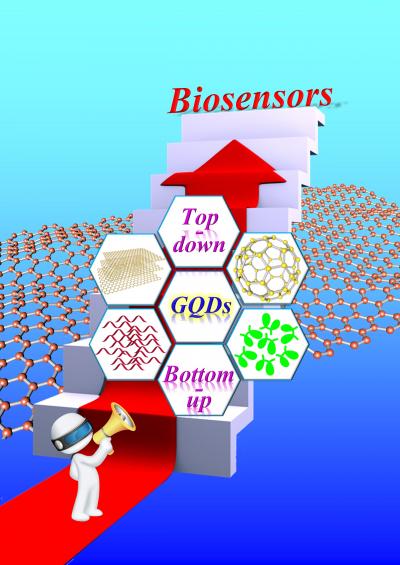
Credit: Authors
In a paper published in NANO, researchers from Hubei, China discuss the top-down and bottom-up strategies for the synthesis of Graphene quantum dots (GQDs). The respective advantages and disadvantages of these methods are summarized. With regard to some important or novel ones, the mechanisms are proposed for reference. In addition, the application of GQDs in biosensors is highlighted in detail.
At present, various top-down methods, such as oxidative cutting, hydrothermal or solvothermal reactions, electrochemical oxidation, ultrasonic-assisted or microwave-assisted process, chemical vapor deposition (CVD) have been reported to produce GQDs. Meanwhile, the bottom-up methods have been developed rapidly, which mainly include carbonization methods and stepwise organic synthesis. Owing to excellent photoelectric properties, good biocompatibility and low cytotoxicity, GQDs are of great value in various domains. In particular, as a novel luminescent nanomaterial, GQDs have played a leading role in the development of biosensors.
The authors review the latest progresses on the synthesis of GQDs. Different methods are presented in order to study their characteristics and the influence on the final properties of the GQDs. The mechanisms of some novel methods are proposed for offering enlightenment in the synthesis. Furthermore, the potential application of GQDs in biosensors and their design solution are introduced. Finally, a brief outlook and further development for GQDs are discussed. This review not only provides a useful guide on the synthesis of GQDs, but also facilitates designing novel biosensor devices for researchers.
###
The authors acknowledge the support from National Natural Science Foundation of China (grant numbers: 21805166), the 111 Project of Hubei Province (grant numbers: D20015), and Foundation of Science and Technology Bureau of Yichang City (grant number: A18-302-a07).
Corresponding author of the paper is Weifeng Chen ([email protected]).
For more insight into the research described, readers are invited to access the paper on NANO.
IMAGE
Caption:
A schematic illustration of the synthesis of GQDs with different stratagies and their applications in the domain of biosensors.
NANO is an international peer-reviewed monthly journal for nanoscience and nanotechnology that presents forefront fundamental research and new emerging topics. It features timely scientific reports of new results and technical breakthroughs and publishes interesting review articles about recent hot issues.
About World Scientific Publishing Co.
World Scientific Publishing is a leading independent publisher of books and journals for the scholarly, research, professional and educational communities. The company publishes about 600 books annually and about 140 journals in various fields. World Scientific collaborates with prestigious organizations like the Nobel Foundation and US National Academies Press to bring high quality academic and professional content to researchers and academics worldwide. To find out more about World Scientific, please visit http://www.
For more information, contact Tay Yu Shan at [email protected].
Media Contact
Tay Yu Shan
[email protected]
Original Source
https:/
Related Journal Article
http://dx.




